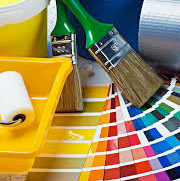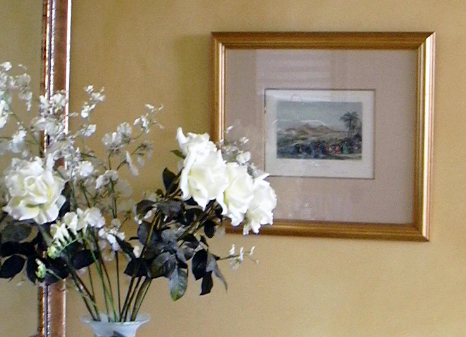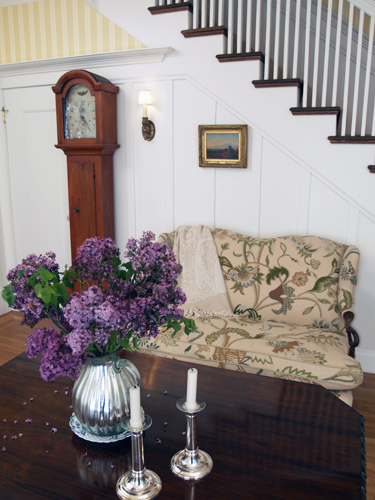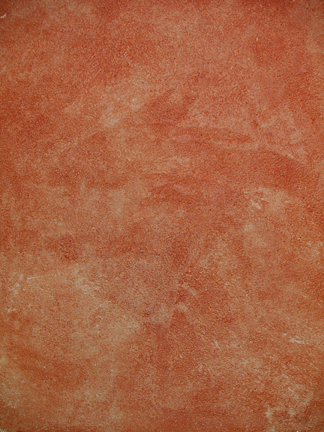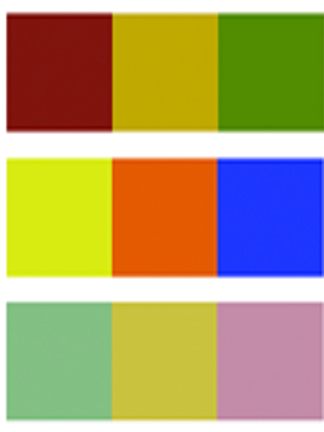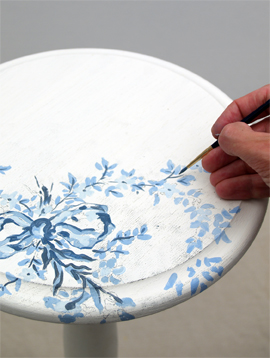The perfect Antique Glaze
How to create the perfect antique glaze for furniture and objects.
Create old world effects and charm using thinned paint and antique glaze solutions. Create your own antique glaze or select from a wide variety of pre-mixed antique glazes.
Antiquing is the process of aging a surface to produce a time-worn appearance. There are many methods of antiquing, but I found that by mastering these few simple steps I’ve been able to successfully handle the antiquing of untold objects, furniture, mural paintings and wall surface finishing.
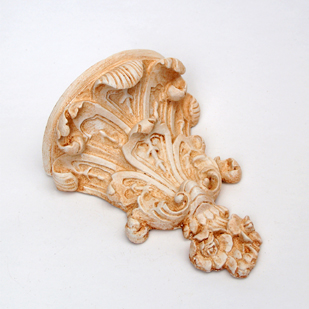
Selecting base colors for your Antiquing project.
TIPS
Create a history for your antiqued objects. I’ve discovered that the best approach to antiquing is to think in terms of the passage of time. What would happen to any given object as it matured through time? Passing from one owner to the next, or resting quietly in the back of a dusty shop. Dirt starts to settle. As people clean or move these objects around, the high points, edges and top would naturally be exposed to polishing, rubbing or knicks and dings. Meanwhile, the recesses and deep areas slowly become more distinguished as they settle and mature. In step 8, above, we see just that. The buffing of the ‘high traffic’ points, while our newly applied antique glaze stays put in the details.
The 'Classic Antique Glaze'. A blending of Raw Umber, Van Dyke Brown and Burnt Sienna colorant.
Base Color Antique White - Latex Eggshell
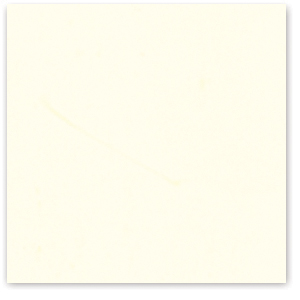
Glaze color Classic Antique Glaze
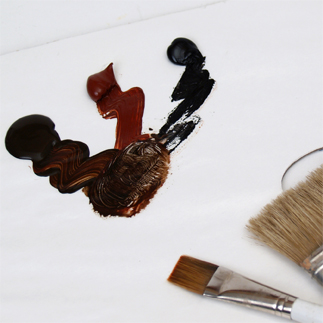
Color Essentials
Mixing with Color.
Create custom color schemes and color effects in your home or office. Learn how to use the best base color, create a glaze, mixing colors, and more. Using color at home or in the office - for paintings, furniture or any artistic challenge - takes a good eye, a little know how, and a creative imagination.
Antiquing Video Tutorial
Turn ordinary objects into heirlooms! Creating the 'Classic Antique' glaze finish for objects, furniture, walls and more. This detailed step-by-step tutorial shows how to mix the right colors to create the perfect antiquing solution for any object, furniture, picture frame and more.
Step-by-step tutorial starts here...
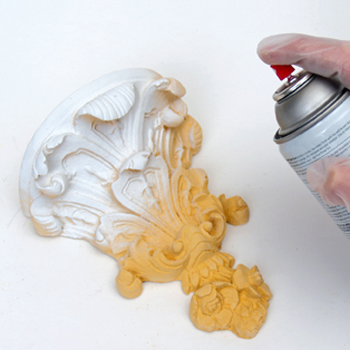
Step 1: Prime Object.
Ensure that the object being antiqued is suitably primed. In this instance I’ve decided to antique a set of decorative wall brackets. Since they are cast in plaster I will need to prime them by using an aerosol white primer.
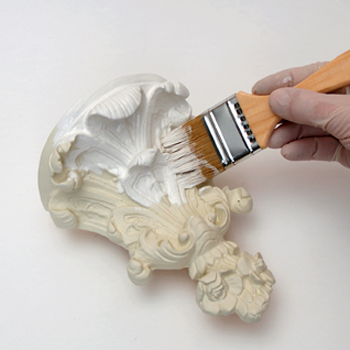
Step 2: Apply base coat.
Apply 2 coats of latex Antique White paint. Establishing a light base color allows the antique glaze to differentiate from the base color, taking on depth and richness of tone.

Step 3: Create 'Classic Antique Glaze'.
To create the artSparx 'Classic Antique Glaze', loosely mix together Raw Umber, Van Dyke Brown and Burnt Sienna in a 4:2:1 ratio onto the paper palette. This is not an exact science so use your color sensibility to adjust the glaze as desired.
This random mixing of the colors, in a not so scientific manner, allows for small variations of color on the object during application. This will further enhance the mottled and aged appearance of the object or surface.
For larger surface areas, follow the Parchment Glaze step-by-step tutorial.
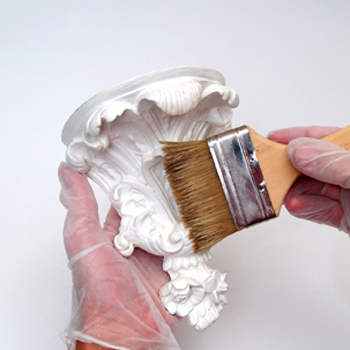
Step 4: Wet surface.
Use a damp rag and wet the working surface with water. This helps your glaze to move fluidly while also extending drying time.
Glazed decorative and faux effects on walls, ceilings furniture and objects.
Create classic effects such as colorwashing, dragging, striee, antiquing effects, or furniture effects.
Our interior and exterior glazes offer a high-end decorative paint solution that provides soft, delicate, subtle shades with either pearl, satin, or glossy tones for maximum depth and decoration.
Flouart is an acrylic based glaze for interior finishes that creates soft shades or spectacular decorative effects. Available in a pearl base, satin base, or clear, Flouart is a washable decorative paint applicable to walls, wood, metal, and plaster. Its inherent versatility allows for thousands of different aesthetic solutions depending on the tools or techniques used to apply it.
Contrast Pearl is a hard-wearing pearlescent paste specifically formulated to create numerous faux effects with one simple application.Pearl dries to a lustrous, satin finish.
Velur Interior or exterior glaze, Velur is an ideal glazing medium for mineral based plaster and stucco effects. Applicable by brush or other faux tools, Velur glaze creates delicate tones and transitions in a wide variety of saturation and opacity.

Step 5: Apply glaze.
Brush the antique glaze you created loosely over the entire surface.
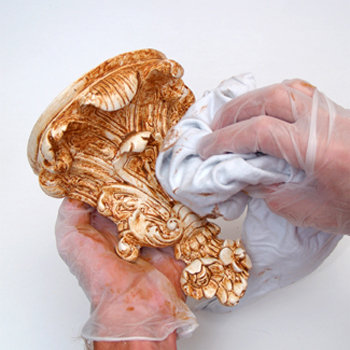
Step 6: Rub glaze with rag.
Ball a clean rag in your hand and then lightly rub over the antique surface with the rag. This will remove glaze from the higher points, creating contrast by allowing the recesses to remain darker, thus exaggerating the natural shadows of your object.

Step 7: Drybrush.
With the dry brush, gently work over the surface, evening out concentrations of antique glaze.

Step 8: Wipe surface and varnish if desired.
Wipe the surface again using the balled up rag to pull out the highlight and even out the glazed surface.
To protect the surface, a clear water-based varnish may be applied after antiqued surfaces have dried compltely (4 hrs). A Satin or Semi-gloss sheen is best suited for this type of treatment.
Early American Style
Colonial Amercians drew inspriation from their European heritage. Curent design styles would filter across the ocean and become reinventedin early America. Proportion and scale took reign over ornementation, A neutral color palette of grey blue, greens and rose pinks is readily apparent.
Stucco Rustico - Aged Plaster
Stucco Rustico is a Traditional interior and exterior textured plaster that epitomizes the rustic old world charm commonly associated with Tuscan environments. I love this treatment for its ease of application and the natural, organic glazed appearance that results when using mineral based plasters and glazes. Whether a rough application or a smooth finish, this treatment holds true to the test of time and, in fact, feels as if time itself stopped to wash the walls personally.
The Rustic Color Palette
The Rustic Style color palette falls within a distinct range of color tones and is essential in creating a successful Rustic interior. By using the appropriate color tones you can create a variety of design styles ranging from Period and Historic, regional or thematic. Color helps define our experiences within an interior and exterior environment. It affects us on a physical, emotional, and spiritual level and can be calming and passive, expressive and vital.
Painted Floral Details
Floral patterns used as accents in fabrics and furniture are common place details in the English Country home. These graceful and organic patterns complement the cozy interior of this style and work particularly well with lace window treatments, an heirloom tea service set and the natural and rustic charm of wooden ceiling beams and slightly irregularly textured walls.

